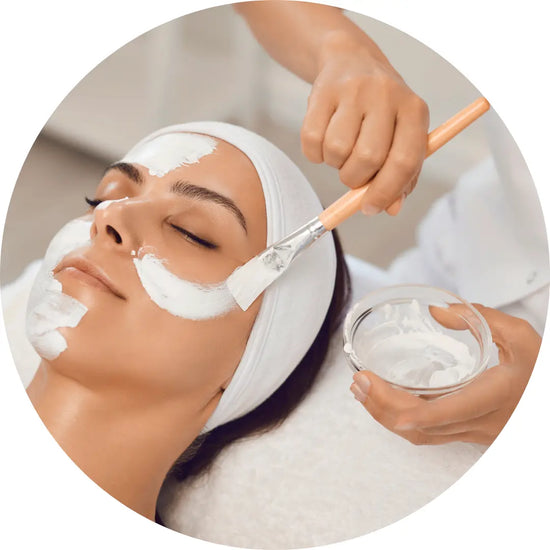Are Eye Creams Effective?
Yes, eye creams can be effective, especially when formulated with the right ingredients to target specific concerns around the delicate eye area. The skin around the eyes is thinner and more sensitive than the rest of the face, making it more susceptible to signs of aging, dryness, and environmental damage. Here’s why eye creams can be effective and the benefits they offer:
Targeted Formulation for the Delicate Eye Area
Thinner Skin: The skin around the eyes is about 10 times thinner than the skin on the rest of the face, making it more prone to dryness, fine lines, and wrinkles. Our eye creams are specially formulated to be gentle yet effective for this delicate area.
Reduced Irritation: Regular face creams may be too heavy or contain ingredients that can irritate the sensitive skin around the eyes. Eye creams are typically formulated with milder ingredients to reduce the risk of irritation.
Address Specific Concerns
Fine Lines and Wrinkles: Eye creams often contain anti-aging ingredients to minimise the appearance of fine lines and wrinkles. These ingredients boost collagen production, improve skin elasticity, and provide deep hydration to plump up the skin.
Dark Circles: Ingredients like niacinamide are commonly found in eye creams to help brighten the under-eye area and reduce the appearance of dark circles. Caffeine helps constrict blood vessels, reducing the pooling of blood that can lead to dark shadows.
Puffiness: Puffiness around the eyes is often caused by fluid retention or lack of sleep. Eye creams can help reduce puffiness and soothe the skin.
Hydration: The eye area lacks oil glands, making it more prone to dryness. Eye creams can help to keep the skin moisturised, preventing dryness and the formation of fine lines.
Preventative Care
Early Protection: Using an eye cream early on can help prevent the signs of aging before they become pronounced.
Maintains Skin Health: Regular use of eye cream can maintain the health and appearance of the skin around the eyes, keeping it firm, hydrated, and resilient against daily stressors.
Boosts Effectiveness of Makeup Application
Smooth Base: Hydrated and well-cared-for skin around the eyes creates a smooth base for makeup application. Eye creams can prevent concealer from creasing and settling into fine lines, resulting in a more even and long-lasting makeup finish.
Minimises Caking: By keeping the under-eye area moisturised, eye creams can prevent the cakey appearance that can occur when makeup is applied over dry or flaky skin.
Enhanced Absorption and Delivery
Smaller Molecules: Eye creams are often formulated with smaller molecules and lighter textures to ensure they can penetrate the thinner skin around the eyes effectively. This allows for better absorption of active ingredients.
Focused Application: The targeted nature of eye creams means that potent ingredients are delivered directly to the area where they are needed most, enhancing their effectiveness.
Consistency is Key
Regular Use: For eye creams to be effective, they should be used consistently as part of your daily skincare routine. While some benefits, like hydration and de-puffing, may be seen quickly, others, like reducing fine lines and dark circles, may take longer to become noticeable.
Choosing the Right Eye Cream
Identify Concerns: Select our eye cream based on your specific concerns—whether it’s anti-aging, dark circles, puffiness, or hydration and for the men try our men's range eye cream.
Patch Test: If you have sensitive skin, perform a patch test before using a new eye cream to ensure it doesn’t cause irritation.
Can Eye Creams Help With Dark Circles?
Yes, eye creams can help reduce the appearance of dark circles, especially when they contain specific ingredients that target the underlying causes of this common issue. Dark circles under the eyes can result from various factors, including genetics, lack of sleep, aging, hyperpigmentation, and lifestyle habits. Here's how eye creams can help and what ingredients to look for:
Types of Dark Circles and Causes
Genetic Predisposition: Some people are genetically prone to dark circles due to the thinness of the skin around the eyes or naturally occurring hyperpigmentation.
Blood Vessel Visibility: In some cases, dark circles are caused by the visibility of blood vessels under the thin skin of the eye area. This can result in a blue or purple tint.
Pigmentation: Hyperpigmentation, often due to sun exposure or hormonal changes, can cause dark circles that appear brownish.
Lack of Sleep and Fatigue: Tiredness can lead to dull skin and make blood vessels more visible, worsening the appearance of dark circles.
Aging: As we age, the skin loses collagen and becomes thinner, making veins more noticeable and leading to hollowing that can cast shadows.
How Eye Creams Help with Dark Circles
Brightening Ingredients: Eye creams with brightening agents like vitamin C, niacinamide can lighten dark circles by reducing melanin production and evening out skin tone. These ingredients help to fade pigmentation and improve overall radiance.
Peptides: Peptides help strengthen the skin and stimulate collagen production, which can thicken the delicate skin around the eyes, reducing the visibility of blood vessels and minimizing the appearance of dark circles.
Retinol: Retinol, a form of vitamin A, helps improve cell turnover and can thicken the skin, making underlying blood vessels less visible. It also reduces pigmentation and enhances skin texture, contributing to a brighter, more youthful appearance.
Hyaluronic Acid and Hydrators: Hydrating ingredients like hyaluronic acid help plump the skin, which can reduce the appearance of hollowing and shadows that contribute to dark circles. Well-hydrated skin looks smoother and more radiant.
Antioxidants: Ingredients like coenzyme Q10 found in our day creams protect the skin from oxidative stress and free radical damage, which can contribute to pigmentation and aging. Antioxidants help maintain the skin's health and brighten the under-eye area over time.
Choosing the Right Eye Cream for Dark Circles
Identify the Cause: Understanding the cause of your dark circles can help you choose the most effective eye cream. If your dark circles are due to pigmentation, look for brightening ingredients. If they are due to thin skin or visible blood vessels.
Ingredients to Look For: Look for eye creams that contain a combination of brightening agents. These ingredients work together to improve the appearance of dark circles.
Fragrance-Free Formulas: Since the eye area is sensitive, choose eye creams that are free from fragrances and harsh chemicals to minimise the risk of irritation.
Consistency is Key
Regular Use: Eye creams for dark circles should be used consistently, typically twice a day (morning and night) for best results. Apply the cream gently with your ring finger, tapping it around the orbital bone, avoiding direct contact with the eyes.
Patience: Dark circles may take time to improve, especially if they are due to genetic factors or long-term pigmentation. Give the eye cream at least a few weeks to show noticeable results.
Additional Tips for Reducing Dark Circles
Sun Protection: Always use sunscreen during the day, including around the eyes, to prevent further pigmentation and protect against UV damage.
Healthy Lifestyle: Get adequate sleep, stay hydrated, and maintain a balanced diet to support overall skin health. Reducing alcohol and caffeine intake can also help minimise under-eye darkness.
Cold Compress: Applying a cold compress or chilled cucumber slices can help reduce puffiness and constrict blood vessels, temporarily reducing the appearance of dark circles.
Can Eye Cream Be Used On Eyelids?
While eye creams are formulated specifically for the delicate skin around the eyes, including the under-eye area and the outer corners where crow's feet might develop, they are generally not recommended for use on the eyelids. Here’s why, along with guidelines on how to properly use eye creams:
Thin and Sensitive Skin on Eyelids
Delicate Nature: The skin on the eyelids is even thinner and more sensitive than the skin under the eyes. Eye creams are to be used around the orbital bone and under the eyes, where the skin is less fragile compared to the eyelids.
Risk of Irritation: Because the eyelids are so sensitive, applying eye cream directly to them can lead to irritation, redness, swelling, or a stinging sensation. Eye creams contain active ingredients, which can be too potent for the delicate eyelid area.
Potential for Migration
Product Migration: When applying eye cream around the eyes, there’s a natural tendency for the product to migrate due to body heat and movement. If eye cream is applied too close to the eyelids or directly on them, it can easily move into the eyes, causing discomfort or irritation.
Safety Concerns: Some ingredients in eye creams are not meant to come into direct contact with the eyes. If they migrate into the eyes, they can cause stinging, watering, or more serious issues like allergic reactions.
How to Properly Apply Eye Cream
Apply Along the Orbital Bone: The safest and most effective way to apply eye cream is to dot it along the orbital bone, which circles the eye socket. Use your ring finger, as it applies the least pressure, to gently tap the product into the skin. This method helps ensure that the cream is close enough to benefit the under-eye area and outer corners without risking irritation of the eyelids.
Avoid the Lash Line: Keep the application area to the bony part surrounding the eyes and avoid the upper lids and lower lash lines. This minimises the risk of product migrating into the eyes.
Gently Pat, Don’t Rub: Patting helps the cream absorb into the skin without pulling or stretching the delicate eye area, reducing the chance of irritation.
Special Formulations for Eyelids
Specific Eyelid Products: If you have concerns about your eyelids, such as dryness or sagging, look for products specifically formulated for eyelid use. Some brands offer eye serums or gels that are designed to be gentle enough for the upper eyelids, often marketed as “eyelid creams” or “eyelid treatments.”
Consult a Dermatologist: For targeted treatment of issues like drooping eyelids or severe dryness, it's best to consult a dermatologist. They can recommend appropriate products or treatments that are safe for use on the eyelids.
Alternatives to Eye Cream on Eyelids
Use a Lightweight Moisturiser: If you feel the need to moisturise your eyelids, our gentle, fragrance-free moisturiser can sometimes be applied sparingly, as long as it is safe for sensitive skin and you avoid getting it too close to the eyes.
Hydrating Mists: Hydrating mists formulated for sensitive skin can provide light moisture to the eyelids without the risk of migration associated with creams.
When Should I apply my Eye Cream During My Skincare Routine?
Applying eye cream at the right time in your skincare routine is essential to maximise its effectiveness and ensure that it works harmoniously with other products. Here’s a step-by-step guide on when to apply eye cream in your skincare routine:
Cleanse Your Face
Start with Cleansing: Begin your skincare routine by thoroughly cleansing your face to remove makeup, dirt, oil, and impurities. This step ensures that your skin is clean and ready to absorb the products that follow.
Double Cleansing (Optional): If you wear makeup or sunscreen, you might use an oil-based cleanser first to remove these products, followed by a water-based cleanser to clean the skin. This method helps ensure all traces of makeup and dirt are removed.
Apply Toner
Balance and Prep: After cleansing, apply a toner to balance the skin's pH and prepare it for better absorption of subsequent skincare products. A toner can also help remove any remaining impurities.
Application Method: You can apply toner using a cotton pad or by patting it directly onto your skin with your hands.
Apply Eye Cream
Before Serums and Moisturisers: Our eye cream should be applied before your face serums and moisturisers. The reason is that eye creams are typically formulated to be lighter and more concentrated for the delicate skin around the eyes. Applying it first ensures that it can be absorbed properly without being blocked by heavier products.
Apply Serums
Targeted Treatments: After your eye cream, apply our face serums. Our serums are typically used to address specific skin concerns such as aging, pigmentation, or hydration. The lightweight consistency of serums allows them to penetrate the skin deeply.
Apply in Layers: If using multiple serums, apply them in order of their consistency, from thinnest to thickest. Allow each serum to absorb fully before applying the next.
Moisturise
Seal in Hydration: After applying your serums, apply your moisturiser to lock in hydration and create a barrier that protects your skin throughout the night or day.
Face and Neck: Don’t forget to apply moisturiser to your neck as well, as it also needs hydration and care.
Apply Sunscreen (Morning Routine)
Sun Protection: If you’re applying eye cream as part of your morning routine, don’t forget to apply a broad-spectrum sunscreen as the final step. Sunscreen protects your skin from harmful UV rays and prevents premature aging and pigmentation.
Face and Eye Area: Apply sunscreen all over your face, including the area around your eyes. Be cautious not to apply too close to the eyes to avoid irritation.
Additional Tips for Applying Eye Cream
Use Morning and Night: For best results, use eye cream both in the morning and at night. In the morning, choose a lighter, hydrating formula that works well under makeup. At night, you can opt for a more nourishing or anti-aging formula.
Consistency: Be consistent with your use of eye cream. Regular application is key to seeing long-term benefits, such as reduced fine lines, puffiness, and dark circles.
Patience: It may take a few weeks to see noticeable results from your eye cream. Be patient and consistent with your routine.
Do Eye Creams Actually Work?
Yes, eye creams can work effectively, especially when they are formulated with ingredients that target specific concerns around the delicate eye area. While they are not miracle cures, the right eye cream can help improve the appearance of common issues such as fine lines, wrinkles, puffiness, and dark circles. Here’s a breakdown of how and why our eye creams can be effective:
Targeted Formulation for the Delicate Eye Area
Thinner Skin: The skin around the eyes is thinner and more delicate than the rest of the face, making it more prone to signs of aging, dryness, and environmental damage. Eye creams are specifically formulated to be gentle yet effective, providing the right level of hydration and protection without causing irritation.
Reduced Irritation: Many face creams may contain ingredients that are too strong for the sensitive eye area, potentially causing irritation or stinging. Eye creams are usually formulated without harsh ingredients, making them safer for use around the eyes.
Address Specific Concerns
Fine Lines and Wrinkles: Eye creams often contain anti-aging ingredients,These ingredients help stimulate collagen production, improve skin elasticity, and plump up the skin, reducing the appearance of fine lines and crow’s feet.
Dark Circles: Our Ingredients can help brighten the under-eye area and reduce dark circles. These ingredients work by lightening pigmentation, constricting blood vessels, and reducing fluid retention.
Puffiness: Puffiness around the eyes is often due to fluid retention, allergies, or lack of sleep.
Hydration: The eye area has fewer oil glands, making it more susceptible to dryness. Hydrating ingredients in our eye cream help keep the skin moisturised, preventing dehydration and the formation of fine lines.
Preventative Care
Early Protection: Using an eye cream early on can help delay the onset of aging signs around the eyes. Antioxidants in eye creams help protect the skin from free radical damage, which contributes to premature aging.
Maintains Skin Health: Consistent use of eye cream can keep the skin around the eyes healthy, firm, and resilient. Eye creams can help prevent dryness, reduce the appearance of early wrinkles, and maintain a youthful look.
Enhanced Absorption and Delivery
Lighter Consistency: Our eye cream is typically lighter than face moisturisers, making them more suitable for the delicate eye area. This lighter consistency allows for better absorption of active ingredients, ensuring that they reach the areas where they are most needed.
Smaller Molecules: Many eye creams are formulated with smaller molecules, which can penetrate the thinner skin around the eyes more effectively, delivering active ingredients directly to where they can have the most impact.
Boosts Effectiveness of Makeup Application
Smooth Base: Hydrated and well-cared-for skin around the eyes provides a smooth base for concealer and makeup application. Eye creams help prevent concealer from creasing and settling into fine lines, resulting in a more flawless and natural-looking finish.
Minimises Caking: By keeping the under-eye area moisturised, eye creams prevent the cakey appearance that can occur when makeup is applied over dry or flaky skin.
Consistency is Key
Regular Use: The effectiveness of eye creams often depends on consistent use. Applying eye cream both morning and night as part of your daily skincare routine can help maintain hydration and address specific concerns over time.
Long-Term Benefits: While some benefits, like hydration and de-puffing, may be seen quickly, other effects such as reducing fine lines and dark circles may take several weeks or months of consistent use to become noticeable.
Choosing the Right Eye Cream
Identify Your Concerns: Select an eye cream based on your specific concerns, whether it’s anti-aging, dark circles, puffiness, or hydration.
Patch Test: If you have sensitive skin, perform a patch test before using a new eye cream to ensure it doesn’t cause irritation.



















